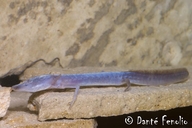|
Eurycea waterlooensis Hillis, Chamberlain, Wilcox & Chippindale, 2001
Austin Blind Salamander Subgenus: Typhlomolge | family: Plethodontidae subfamily: Hemidactyliinae genus: Eurycea |
 © 2007 Danté B Fenolio (1 of 6) |
|
|
Eurycea waterlooensis Hillis, Chamberlain, Wilcox and Chippindale,
2001 Paul T. Chippindale1 1. Historical versus Current Distribution. Austin blind salamanders (Eurycea waterlooensis) are a newly discovered species known only from the outflows of Barton Springs in the city of Austin, Travis County, Texas. A formal description is given in Hillis et al. (2001). This subterranean species is most closely related to Texas blind salamanders (Eurycea [formerly Typhlomolge] rathbuni) and Blanco blind salamanders (Eurycea [formerly Typhlomolge] robusta); both species occur in or near San Marcos, Hays County, Texas (Hillis et al., 2001). Only a few specimens are available, and Austin blind salamanders are much more rarely encountered than Barton Springs salamanders (E. sosorum), which occur on the surface at Barton Springs. 2. Historical versus Current Abundance. Unknown. 3. Life History Features. A. Breeding. i. Breeding migrations. Unknown. ii. Breeding habitat. Unknown. B. Eggs. i. Egg deposition sites. Unknown. ii. Clutch size. Unknown. C. Larvae/Metamorphosis. This species is paedomorphic, and natural metamorphosis is unknown. Several specimens obtained as juveniles grew in captivity from about 15–60 mm TL in 8 mo, at which time they were presumed to be sexually mature (Hillis et al., 2001). D. Juvenile Habitat. Probably similar to those of adults. E. Adult Habitat. Completely aquatic. Austin blind salamanders are known only from spring outflows (juveniles that probably washed out accidentally); this species almost certainly is a cave dweller. Water temperature in the Barton Springs Aquifer is relatively constant at about 20 ˚C. Sweet (1982) provided a comprehensive distributional analysis of the central Texas Eurycea and discussed hydrogeology of the region in relation to salamander distribution. F. Home Range Size. Unknown. G. Territories. Unknown. H. Aestivation/Avoiding Dessication. Unknown. I. Seasonal Migrations. Unlikely to occur. J. Torpor (Hibernation). Probably active throughout the year. K. Interspecific Associations/Exclusions. Partially sympatric with Barton Springs salamanders. L. Age/Size at Reproductive Maturity. Unknown, but based on growth patterns for captive specimens, this species probably matures at about 60 mm total length. The largest known specimen (maintained alive by the City of Austin) had a total length of about 79 mm in July 2000. The largest known preserved specimen is 35.6 mm SVL with a total length of 66.6 mm (2 mm of tail tip missing). M. Longevity. Unknown. N. Feeding Behavior. Prey probably consists mainly of aquatic invertebrates, but no feeding studies of this species have been conducted. O. Predators. Unknown. P. Anti-Predator Mechanisms. Unknown. Q. Diseases. Unknown. R. Parasites. Unknown. 4. Conservation. Austin blind salamanders are a newly discovered species known only from the outflows of Barton Springs in the city of Austin, Travis County, Texas. Only a few specimens are available, and Austin blind salamanders are much more rarely encountered than syntopic Barton Springs salamanders, which occur on the surface at Barton Springs. Austin blind salamanders are currently listed by the Federal Government as a Candidate species; they receive no special protection in Texas.1Paul T. Chippindale Literature references for Amphibian Declines: The Conservation Status of United States Species, edited by Michael Lannoo, are here. Feedback or comments about this page.
Citation: AmphibiaWeb. 2024. <https://amphibiaweb.org> University of California, Berkeley, CA, USA. Accessed 24 Apr 2024. AmphibiaWeb's policy on data use. |




 Raffaëlli Account
Raffaëlli Account Map of Life
Map of Life